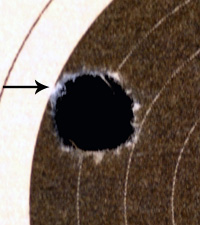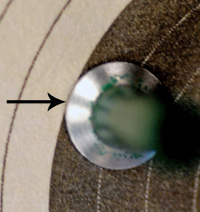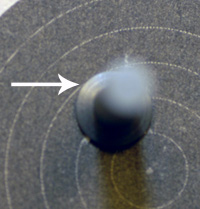

| We want your feedback! Please let us know what you think about TFS. Do you have an interesting story or article that you would like to share? If so, please let us know!
|
Reader Comments:
CMP Shooters' News is one of my favorite email news publications. Information packed, talented authors, timely subjects, and all around well done. What a great service you are providing to the shooting community. Just wanted to say thanks and Merry Christmas.
Newt E.
I enjoy and look forward to TFS and the excellent articles that are published on a regular basis.
Please keep this publication coming and keep the CMP active.
Don M.
One of the members at Snipers Hide pointed out the newsletter and the High Power Tips articles by the USAMU team.
Darn you! I was up until 1:00 AM last night reading all of the articles. Great newsletter and really great USAMU articles.
Thanks,
Michael E.
Great article written on physical conditioning in the latest TFS. I was one of likely many who had asked about the type of conditioning recommended for serious shooters. Sgt. Craig did a great job on describing the routines. Now it’s my turn to put it to work.
Thanks to you, Sgt. Craig and other contributors who share best practices of shooting excellence.
Sincerely,
Keith H.
I use these articles in our high power clinics and have found them very helpful for both new shooters and reinforcement of the basics for the more experienced.
Thanks, Gary M.
Thanks for the great articles on the Carbine, Springfield, Garand matches. All the articles are interesting, but the Carbine, Springfield & Garand are my favorites.
Jim H.
The September-07 on line shooting tips by SSG Tobie Tomlinson, USAMU Service Rifle Team Member, is a great article. I have reproduced 15 copies of it to hand out and discuss to our “newbie” first year air rifle shooters on our high school JROTC Air Rifle Team. Come to think about it believe I’ll hand out a copy to my advance shooters as well. His explanations are simple to understand but rich in detail. Coupled with the sight pictures this article will go a long way towards helping all our JROTC shooters obtain better sight patterns. Keep up the great work. AND…..keep the articles like this coming.
Malcolm V.
CW2 (R), US Army
It seemed good to read the article on Infantry Trophy Match. As a shooter on the Marine Corp Team way back in 1967 I participated in the Match. We were the second team for the Marines but placed second overall. One of our shooters forgot to put the windage on his rifle. I enjoyed shooting the M-1 and M-14 at Camp Perry and always wanted to go back but never seemed to find the time. The top over all shooter at that time was my team mate Lt. Bowen. I remember some of the team members carrying him from the 600 yd line back to the rest of us. It was a great time in my life and will never forget it. Thanks again for the article.
Mike A.
Thanks for the great series of articles from the USAMU – they are very readable, and usable!
Tom, AZ
Great articles. Great to identify those who are participating as well as those who are working behind the scenes to make the whole of the National Matches run so well.
David D.
Boxford, MA
This is a special note just for my friends at the CMP, I want to thank you all for your hard work and attention to details, it's a great program!
"You help our shooting dreams come true!"
Best Regards,
Tony M.
|
|
|
 |
A Plea for Improved Scoring
By Gary Anderson, DCM
|
|
Ten-meter air rifle targets and 50-foot smallbore targets are very difficult to score accurately because the scoring rings and 10-dots are small and easy to misjudge. It is not surprising then that many match sponsors and coaches score these targets inaccurately, with a result that scores given are usually higher than scores fired. This article seeks to challenge everyone who scores targets to place greater emphasis on learning how to score accurately to assure that paper target scoring becomes significantly better than it is now.
|
#1: Is this shot a 10 or 9? |
|

|

|
|
#1: Look at the outside of the shot hole, not whether it might touch the 10-dot. If there is not a distinct black space between the outside of the shot hole and the inside of the 8 ring, the shot will almost always score a 9 regardless of whether it looks like the shot hole is close to the 10-dot.
|
#1 with gauge inserted. It is clearly a 9—not even close. Remember—this is an outside gauge.
|
As a result of administering postal competitions with thousands of participants every year and of providing results services for several major air gun competitions, the CMP staff has accumulated considerable experience in scoring targets and in evaluating the scoring done by match sponsors. We know that many air rifle targets are not being scored accurately and that most of these errors can be eliminated by better knowledge of how to score and by better training of scorers. A few examples should illustrate our concern and conclusions.
The CMP acts as the clearinghouse for Three-Position Air Rifle National Records that are fired under National Three-Position Air Rifle Council rules. The process of submitting National Records for approval also requires match sponsors to submit the targets. Two recent four-person team records were scored too high, by a minimum of six and 13 points respectively. A couple of recent individual record scores are also in danger of being rejected because they were scored too high. In evaluating these potential record targets, no shots that were marked as having been gauged and judged by at least two scorers were determined to be incorrect even if there were concerns that the scorers’ decisions were correct. The shots that were scored down were in almost every case, shots that should have been gauged, but were not.
Accurate scoring begins with using the correct scoring gauge and knowing how to read that gauge. All air rifle shots except shots in the 1 and 2-rings must be scored with a 5.5mm “outward gauge.” New scorers must be taught to begin by studying the scoring rules. Rule 8.0 in the National Standard Three-Position Air Rifle Rules governs air rifle scoring. Pay particular attention to the diagram on how to read an outward gauge. To score a higher value, the outer edge of the gauge must be tangent to or inside the outer edge of the second scoring ring away from the value being determined.
|
#1: Is this shot a 6 or 5? |
|

|

|
|
#2: It appears that the inside of the shot hole touches the 6-ring, but look at the outside. The outside breaks the 4-ring—there is no black gap.
|
#2 gauged: Even though the shot hole appears to touch, it must be gauged. And it gauges out—it’s a 5. The outside of the shot hole was a better indicator of value.
|
A primary reason why inaccurate air rifle scoring takes place is that scorers do not know how to look at a shot hole and properly determine whether it should be gauged. The examples provided with this article demonstrate how initial appearances can be deceiving. In each of these shots there is some visual indication that the shot might score the higher value. We have found that many scorers simply “eyeball” shots like this and decide they are “in” without even gauging them. In each case, the gauge shows that the shots are clearly “out.” A lot of extra points are being given to shooters because of this error.
One of the primary reasons why looking at air rifle shot holes is so deceptive is due to the poor quality target paper available in the U. S. Air rifle pellets typically cut shot holes that are larger than the 4.5mm pellet on virtually all U. S. targets. As it punches through the paper, the pellet tears small bits of target paper fibers from outside of the pellet diameter to leave an enlarged shot hole. We have seen several shot holes so large that the 10-dot is obliterated; yet the shot still scores a nine when a gauge is inserted.
|
#1: Is this shot a 9 or 8? |
|

|

|
|
#3: It appears that this shot touches the 9-ring, but look at the outside of the hole—the outside edge is very close to the 7 ring—it must be gauged.
|
#3 gauged: The gauge shows that this shot is also out—it’s an 8. A visual “touch” can be very misleading—always gauge these shots anyway.
|
Accurate scores are determined by how far the center of the shot hole is from the center of the target, not by whether an enlarged shot hole touches a scoring ring. The scoring gauge can accurately find the true center of the shot hole, but because the outside of the shot hole may be larger, accurate scoring can only be done by using an outward scoring gauge that is 5.5mm in diameter, not 4.5mm, and by reading the gauge on the outside of a scoring ring that is not damaged by the pellet hole.
Good scorers understand that shot holes may be larger than 4.5mm and that they must gauge every shot that is doubtful. Do not determine whether a shot is doubtful by looking at the inside of the shot hole. The illustrations here show how deceptive that can be. Instead, look at the outside of the shot hole. If there is not a distinct black gap between the outside of the shot hole and the inside of the outer scoring ring, the shot is doubtful and must be gauged.
|
#1: Is this shot a 10 or 9? |
|

|

|
|
#4: Here’s another shot that looks like it might touch the 10-dot, but in air rifle scoring, never assume that it does.
|
#4 gauged: It’s obviously a nine—again not even close! Just because it looks like it touches does not prove anything—only the gauge does.
|
If scorers understand that air rifle shot holes are typically larger than 4.5mm and that looking at the outside of the shot hole is a surer way to determine whether a shot hole is doubtful and must be gauged, and if they do this with an outward gauge that is properly read, most of the errors in scoring we have seen would be eliminated. After all, the objective of target scoring is to give the shooter the score they actually fire, not an inflated, false score.
NEXT ARTICLE
|
|
|


